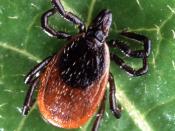Disease: Lyme disease
Pathology
The symptoms of Lyme disease are not very detectable unless one knows what they are looking for. The early symptoms are often flu-like with a fever, headache, stiff neck, joint and muscle pain, and fatigue, also a rash may appear. The rash is red, circular, smooth, and expands over time. It resembles a bull's eye. However, the rash is painless, does not itch, and often disappears on its own so it goes untreated. If the early symptoms go detected then it can lead to chronic problems affecting the heart and can cause neurological disorders. The bacteria that is released in the bloodstream, Borrelia, allows immune cells to attack components of the body and divide rapidly, increase the number, and affect the immune system to go against the person. Lyme disease is not deadly. It can cause some discomfort because it can lead to arthritic pains in half the cases, peripheral central nervous system damage in fifteen percent of cases, and a disruption in heart rhythm in eight percent of the cases.
Transmission
Lyme disease is passed onto a person from a tick, primarily the deer tick which are found on many animals like deer or sheep. The tick must bite the person for the disease to be passed on; the tick usually bites for two or more days. When the deer tick bites a person the bacteria is transmitted into the bloodstream and travels through the body. The bite is usually not felt by the individual so it goes undetected until symptoms are noticed.
Incidence
Lyme disease affects about 16,000 people annually. Those who are most prone to the disease are those who live in the Northeast, Midwest, northern California, and southern Oregon. However, there have been cases all over the country and also in Europe,



Good
you could add to the interest level for this topic by citing real cases from medical journals ect. otherwise good work!
1 out of 1 people found this comment useful.